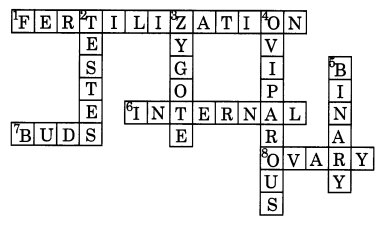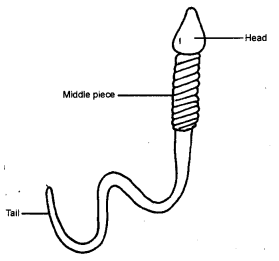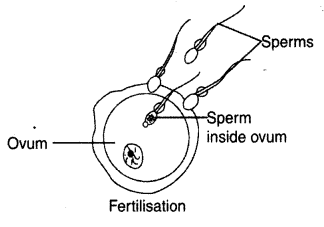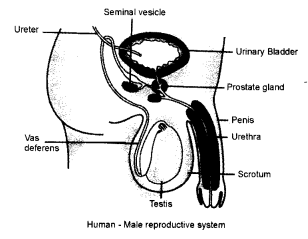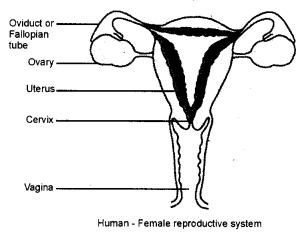Question 1.
Explain the importance of reproduction in organisms.
Reproduction is a vital phenomenon on this planet earth which is essential for existence and continuity of life and species on it, generation after generation.
Question 2.
Describe the process of fertilisation in human beings.
In the process of fertilisation, sperms come in contact with an ova (egg). One of the sperms may fuse with the egg. The nuclei of the sperm and the egg fuse to form a single nucleus resulting in the formation of a fertilised egg called zygote. In human being, the fertilisation takes place inside the female body, known as internal fertilisation.
Question 3.
Choose the most appropriate answer.
(a) Internal fertilisation occurs
(i) in female body.
(ii) outside female body.
(iii) in male body.
(iv) outside male body.
(b) A tadpole develops into an adult frog by the process of:
(i) fertilisation
(ii) metamorphosis
(iii) embedding
(iv) budding
(c) The number of nuclei present in a zygote is:
(i) none
(ii) one
(iii) two
(iv) four
(a) (i)
(b) (ii)
(c) (ii)
Question 4.
Indicate whether the following statements are True (T) or False (F).
- Oviparous animals give birth to young ones.
- Each sperm is a single cell.
- External fertilisation takes place in frog.
- A new human individual develops from a cell called gamete.
- Egg laid after fertilisation is made up of a single cell.
- Amoeba reproduces by budding.
- Fertilisation is necessary even in asexual reproduction.
- Binary fission is a method of asexual reproduction.
- A zygote is formed as a result of fertilisation.
- An embryo is made up of a single cell.
- False
- True
- True
- False
- True
- False
- False
- True
- True
- False
Question 5.
Give two differences between a zygote and a foetus.
| Zygote | Foetus |
| (i) It is a single celled, i.e., it contains only one cell. | (i) It is multicelled, i.e., it contains many cells. |
| (ii) It is formed by the fusion of male gamete or sperm and female gamete or ova (egg). | (ii) It is formed by the repeated division of the zygote. |
Question 6.
Define asexual reproduction. Describe two methods of asexual reproduction in animals.
The mode of reproduction in which only a single parent is involved is called asexual reproduction. In this type of reproduction, sex cells (gametes) are not produced and no fusion of gametes takes place for the reproduction of zygote or offsprings. Asexual reproduction takes place in Amoeba, Hydra, yeast, starfish, sponges, etc.
There are mainly two methods of asexual reproduction:
(i) Binary fission: In binary fission, a single parent cell is divided into two equal individual cells as in Amoeba. It divides into two by division of their bodies, each of them gets one nucleus and develops into separate individual. The figure given below shows how binary fission occurs in Amoeba.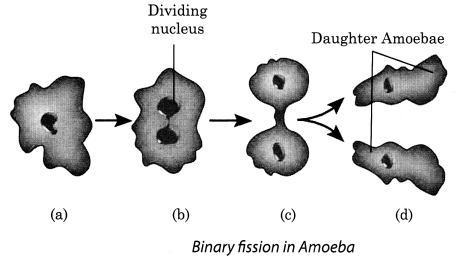
(ii) Budding: In budding, the organism develops a bulge called bud which further develops into an adult organism and separates itself from the parent body to lead an independent life. This type of reproduction is shown in Hydra. The following figure shows budding in Hydra.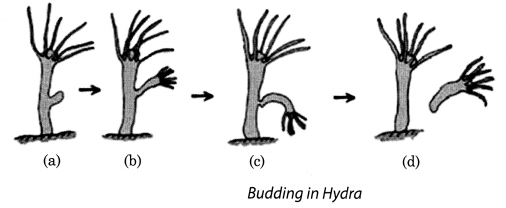
Question 7.
In which female reproductive organ does the embryo get embedded?
Uterus
Question 8.
What is metamorphosis? Give examples.
The transformation of larva into an adult involving sudden and abrupt changes in the body of an ani¬mal during the life cycle of an invertebrate or amphibian is called metamorphosis. Example, frog and butterfly.
Question 9.
Differentiate between internal fertilisation and external fertilisation.
| Internal Fertilisation | External Fertilisation |
| (i) The fusion of male gamete or sperm and female gamete or ova occurs inside the body of a female partner, such as human beings, birds, and mammal. | (i) The fusion of male gamete and female gamete takes place outside the body of a female partner, such as in frog, fish and starfish. |
| (ii) The female partner lays either fertilised eggs or a fully grown young one. | (ii) The female partner discharges unfertilised eggs. |
| (iii) Offsprings have a high chance of survival. | (iii) Offsprings have a low chance of survival. |
Question 10.
Complete the crossword puzzle using the hints given below.
Across
1. The process of the fusion of the gametes.
6. The type of fertilisation in a hen.
7. The term used for bulges observed on the sides of the body of Hydra.
8. Eggs are produced here.
Down
2. Sperms are produced in these male reproductive organs
3. Another term for the fertilised egg.
4. These animals lay eggs.
5. A type of fission in Amoeba.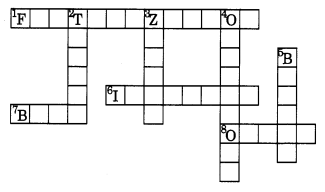
Question 11.
Choose the most appropriate answer
- Internal fertilisation occurs :
- in female body.
- outside female body
- in male body
- outside male body
- A tadpole develops into an adult by the process of
- fertilisation
- metamorphosis
- embedding
- budding
- The number of nuclei present in a zygote is :
- none
- one
- two
- four
- in female body.
- Metamorphosis.
- one
Question 12.
In which female reproductive organ does the embryo get embedded ?
Embedding of the embryo takes place in the wall of the uterus.
Question 13.
Name the male reproductive organs.
The male reproductive organs are a pair of testis, sperm ducts and a penis.
Question 14.
Name the organ producing the male gametes.
Testis produce the male gametes
Question 15.
What are sperms ?
The male gametes produced by the testis are known as sperms.
Question 16.
Give the structure of sperm.
A sperm has a head, a middle piece and a tail.
Question 17.
Draw a labelled diagram of sperm.
Question 18.
Is the sperm a single cell ?
Yes, the sperm is a single cell with all the cell components.
Question 19.
Name the female reproductive organs.
The female reproductive organs are a pair of ovaries, oviducts and the uterus.
Question 20.
Name the organ in the female body where development of the baby takes place.
Uterus.
Question 21.
Is the egg single cell ?
Yes, the egg is also a single cell.
Question 22.
What type of fertilisation takes place in humans and dogs ?
Internal fertilisation.
Question 23.
What type of fertilisation takes place in fish ?
External fertilisation.
Question 24.
What is an embryo ?
The zygote divides repeatedly to form an embryo.
Question 25.
What is a foetus ?
The stage of the embryo in which all the body parts are identifiable is called a foetus.
Question 26.
When does the mother giye birth to the young one ?
When the development of the foetus is complete, the mother gives birth to the young one.
Question 27.
How much time does the embryo of hen take to develop into a chick ?
About three weeks.
Question 28.
What name is given to animals which give birth to young ones ?
Viviparous animals.
Question 19.
What name is given to animals which lay their eggs ?
Oviparous animals.
Question 30.
Do you think metamorphosis takes place in humans ?
No, in humans the body parts similar to the adults are present from the time of the birth.
Question 31.
Define budding.
Budding is the type of asexual reproduction in which new individuals develop from the buds.
Question 32.
Name the method by which Amoeba reproduces.
Amoeba reproduces by binary fission.
Question 33.
All animals finally die, yet the species survives. Give reasons for this.
During the life span, all aniamls reproduce to produce offsprings. So, even after they die, the species survives.
Question 34.
What is metamorphosis ? Give examples.
The drastic change which takes place during the development of an animal is called metamorphosis. Silkworm and frog undergo metamorphosis.
Question 35.
Differentiate between internal fertilisation and external fertilisation.
| Internal Fertilisation | External Fertilisation |
| (a) Fertilisation that takes place inside the female body. (b) Takes place in humans, cows, hens and dogs. |
(a)Fertilisation that takes place outside the female body. (b)Takes place in frogs, fishes and starfish. |
Question 36.
Explain the importance of reproduction in organisms.
Reproduction is essential for the survival of organisms. It ensures the continuation of similar kinds of individuals, generation after generation.
Question 37.
Differentiate between sexual and asexual reproduction.
| Sexual Reproduction | Asexual Reproduction |
| (a)Reproduction which takes place by the fusion of male and female gametes. (b)Takes place in humans, cow. |
(a)Reproduction in which only a single parent is involved. (b)Takes place in hydra and amoeba. |
Question 38.
How many sperms are produced by the testis ? What is the function of tail in sperms ?
Millions of sperms are produced by the testis. The sperms move in oviduct with the help of tail.
Question 39.
What is the function of ovaries ? In human beings, how many eggs are produced every month ?
Ovaries produce female gametes called ova. In human beings, a single mature egg is released every month.
Question 40.
If millions of sperms are transferred from the male to the female body, how many fuse with the egg?
Only one sperm fuses with the egg.
Question 41.
Draw a diagram to show fertilisation in humans.
Question 42.
Differentiate between viviparous and oviparous animals.
| Viviparous Animals | Oviparous Animals |
| (a) The animals which give birth to young ones. (b) E.g., dog, cow, cat. |
(a)The animals which lay eggs. (b) E.g., frog, butterfly. |
Question 43.
How does the size of the egg varies in different animals ?
The egg is very small in humans, much larger in hens and the largest in ostrich.
Question 44.
The different stages of the life cycle of mosquito and silkmoth are given below. Arrange them in proper sequence.
- Mosquito – Pupa —–> Eggs ———> Larva ——-> Adult.
- Silk moth – Larvae ——-> Zygote ——> Cocoon ——> Adult ——–> Caterpillar.
- Eggs —–> Larva ——> Pupa ——–> Adult
- Zygote ——> Larvae ——> Caterpillar ——> Cocoon ——-> Adult.
Question 45.
What are hermaphrodite animals and plants ? Give examples.
Organisms bearing both male and female sex organs on the same body are known as hermaphrodite animals. Example, pea plant, earthworms.
Question 46.
What is fertilisation ? Differentiate between external and internal fertilization. Give two examples of each.
The fusion of male sperms and female ova is called fertilization.
Differences:
| External fertilisation | Internal fertilisation |
| When male gamete fuses with the female gamete outside the body of female, e.g., in fishes and frogs. | When male gamete fuses with the female gamete inside the body of female, e.g., in dogs and human beings. |
Question 47.
Describe the process of fertilisation in human beings.
During fertilisation, the nuclei of the sperm and the egg fuse to form a single nucleus. This results in the formation of the fertilised egg or zygote. During the process of fertilisation, the new individual inherits some characteristics from the mother and some from the father.
Question 48.
Draw a labelled diagram to show the male reproductive system in human beings.
Question 49.
Draw a labelled diagram to show the female reproductive system in human beings.
Question 50.
Explain how external fertilisation takes place in frogs.
During rainy season, frogs and toads move to ponds. When the male and female come together in water, the female lays hundreds of eggs. A layer of jelly holds the eggs together. The male deposits the sperms over them and fertilisation takes place.
